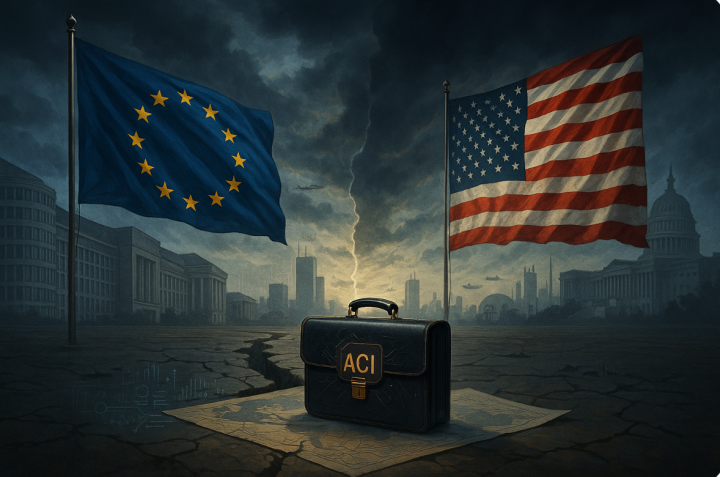
As Brussels prepares for what could become the toughest trade sanctions in years, financial markets remain strikingly calm. With just one week to go until the U.S. deadline of August 1, European policymakers are finalising retaliation measures that could place transatlantic relations under severe strain.
The trigger is a threat by President Donald Trump to impose a 30 percent tariff on European goods. Until recently, a compromise appeared within reach: a 10 percent tariff in exchange for European concessions on defence spending and digital taxation. But that agreement now seems off the table.
In response, Brussels is preparing a so-called “nuclear” alternative: activation of the Anti-Coercion Instrument (ACI), a legal tool designed to counter economic coercion from other countries through retaliatory tariffs or market restrictions.
The ACI has never been used before, but pressure is mounting for Brussels to take a hard line against Washington. Still, markets currently see the risk of real escalation as limited.
“It seems the EU is prepared to offer concessions to reach a deal before the deadline and thereby avoid the 30 percent tariffs,” said Jordy Hermanns, portfolio manager at Aegon Asset Management. “Markets are not pricing in the risk of a no-deal or full 30 percent tariffs at the moment. Any escalation risk is not yet reflected in prices.”
‘A giddy mood’
That view is shared by Mark Dowding, CIO at RBC BlueBay Asset Management, who wrote in a client note that the Trump administration is in a “giddy mood,” convinced that other countries will ultimately concede.
“The U.S. assumes that in the end, it won’t be them but the rest of the world that backs down,” said Dowding, referencing the now-popular acronym TACO: Trump Always Chickens Out.
Still, the Canada-UK based asset manager is not entirely confident: “We see room for volatility around August 1 if the current status quo comes under sudden pressure.”
Retaliation packages ready
Meanwhile, Brussels is preparing several tariff packages, targeting over $100 billion worth of U.S. exports, from peanuts to aircraft. In addition, officials are exploring targeted restrictions on American digital services and access to European public tenders.
The most powerful option remains the ACI. Since 2023, the European Commission has had the authority to deploy the instrument in cases of economic coercion—not just through tariffs, but also via investment restrictions and limitations on market access. **Germany**, long sceptical, has now backed its use following a pessimistic report by Commissioner **Maroš Šefčovič** after his recent trip to Washington. Šefčovič concluded that a 30 percent tariff would make “transatlantic trade practically impossible.”
Still, experts say the chances of full deployment remain slim.
“It’s mainly a way to justify retaliation if the U.S. sticks with 25 percent tariffs. That’s what the instrument was originally designed for,” said Alicia García-Herrero, senior fellow at Brussels-based think tank Bruegel and Chief Economist for Asia-Pacific at Natixis.
‘80 percent chance of a deal’
She believes both sides ultimately want to settle on a 10 percent tariff.
“There’s really no other way, because higher tariffs would drive inflation too far,” she explained. “However, the EU will need to do more than just drop the digital tax and increase defence spending.”
Paul Steidler, senior fellow at the conservative Lexington Institute, also sees a deal as the most likely outcome. “There’s at least an 80 percent chance of a deal,” he said. “It could be vague, general or provisional, but that would be enough.”
He urged Europe to take a more constructive approach toward Washington. “The EU stands to benefit enormously from U.S. investments in AI,” he said. Instead of “demonising” large U.S. tech firms, Europe should work to attract them.
“The best course for the EU is to pursue a free trade agreement with the U.S. for all goods and services.”
Diplomatic misstep still possible
Even if tariffs are avoided, the risk of a diplomatic blunder remains, García-Herrero warned. During the upcoming EU-China summit, which kicks off on Thursday, a joint climate declaration is expected.
“That’s risky,” she said. “The U.S. is currently not engaged in international climate goals, while Europe and China are actively promoting them. Such a declaration could easily be perceived in Washington as a snub, especially at such a sensitive moment.”
Both the U.S. threat and the ACI, García-Herrero emphasised, are mainly negotiation tactics. “But we could still mess it up,” she said. “Let’s hope we don’t.”
This article has been translated from its original in Dutch on InvestmentOfficer.nl.